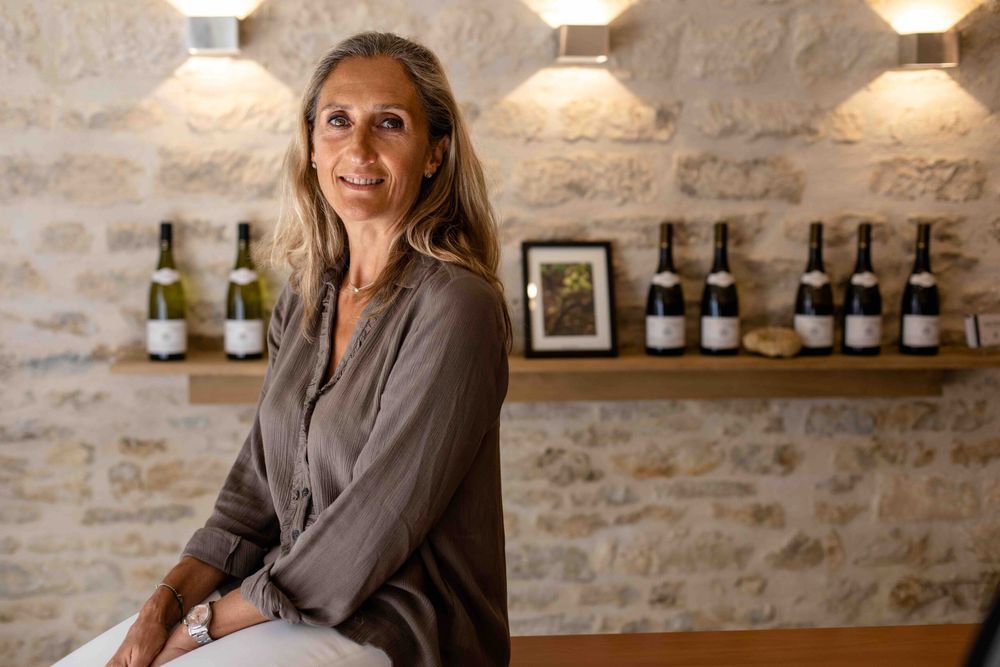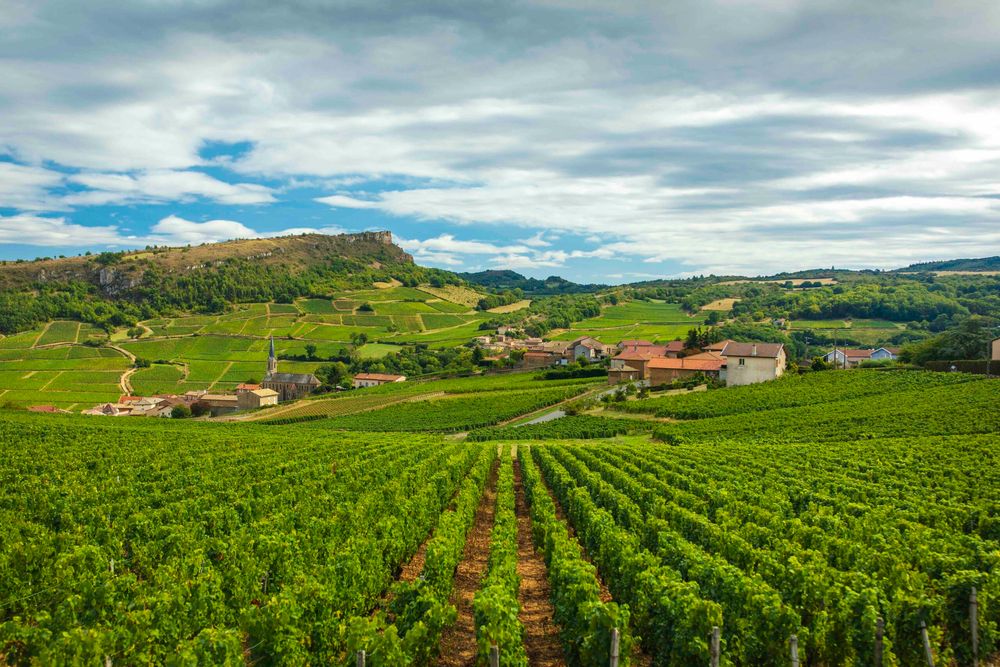Whilst UK importers will lead the way for the traditional Bourgogne Week in the second week of January, many of the region’s most prestigious, and up and coming, producers, will be attending, in person, its generic event in March where the focus will be on showcasing the diversity of this classic French wine region.
“We will be in the UK with our beautiful 2020 vintage which will be such a great opportunity to be back in the UK market.” That’s how Anne Moreau is looking forward to the first quarter of 2022 and the opportunity for Bourgogne to put the troubles of 2021 behind it and do what it does best. Promote and talk about the quality of its red and white wines and share its passion.

Anne Moreau of Chablis producer Louis Moreau says the quality of the 2020 vintage is a real boost for Bourgogne at this difficult time
Yes, the backdrop for Bourgogne could not be more serious with some producers losing practically all their 2021 vintage to a combination of bad weather and frosts the region has not seen to such an extent for decades. But the quality and reaction to the 2020 vintage gives the region the impetus and the platform to get back trading face to face with its vital UK customers and partners – still the biggest and most important wine market for Bourgogne wines in the world.
The last two years has shown just how precarious even the most classic and world-famous wine regions, such as Bourgogne, are to the vagaries of the weather. Charles Dickens may not have had the wine industry in mind when he wrote “it was the best of times, it was the worst of times” but he certainly captured what it has been like working in it over the last two years.
Taking stock
The full impact of the 2021 harvest will take some time to digest, but the Bourgogne Wine Board is now in the position to confirm that overall average production was 50% down, with some producers and appellations as high as 70% short and others facing 30% losses. In all there was 900,000 to 950,000 hectolitres of wine produced, compared to an average year of 1.5m hectolitres.
“The impact of the harvest was very different from one appellation to another so it is hard to generalise,” stresses Moreau.
For a Chablis producer it has been particularly hard to see overall white wine production down by up to 70%.
“There has been so much more serious damage than if we compare it to our last bad harvest in 2016. Then not all the areas were affected, this year no-one was protected in Bourgogne,” says Moreau. “It really was the cherry on the cake,” she adds to 18 months of the Covid-19 pandemic and all the local, national and global lockdowns we have all had to go through.
It’s why she and her fellow Bourgogne producers are so happy, and grateful, that they have such a “beautiful vintage” as 2020 to bring to the market. “Luckily for us all that 2020 was so easy and comfortable by comparison.”
The key now for producers will be to make the 2020 wines last as long as possible.
Building momentum

Bourgogne has suffered badly from frosts and bad weather in 2021 but still has strong sales momentum around the world
It might sound strange to talk about Bourgogne going into 2022 with strong momentum on the back of such a bad harvest, but the last 18 months has seen the global market very much return to Bourgogne during the pandemic and across 2021.
Moreau confirmed overall Bourgogne wine exports are up 12% in volume and 35% in value over the last year, which means the region is going into 2022 very much on the front foot. “The demand is clearly there for our wine,” she adds.
This was seen at the recent Hospices de Beaune charity auction, which is regarded by many in the trade as a bellwether for Bourgogne’s overall position in the market. Although there was around half the volume of wine available to buy it attracted hundreds of both trade and private bidders all vying to buy fewer barrels. The sale of a 228 litre barrel of Corton-Renardes Grand Cru, for example, sold for a record €800,000 and total bids reached €12.5m, slightly down on €13.44m last year when there was almost double the number of barrels being sold. Average price per lot this year was $39,408 compared to €21,690 in 2020. So scarcity can be good for business – or charity in this case.
Bourgogne has also been helped by the “generous quality” of the 2018 vintage and still “fine” 2019, which combined with the strength of 2020 means it is better placed that it might have been to cope with the major fall in volumes for the 2021 harvest.
Classic vintage
Those willing to put their faith in the 2021s will be rewarded, says Moreau, with a “very classic” style where it feels like the region has gone back to its roots. Even the harvest followed a normal path, starting with picking Crémant de Bourgogne on September 8, compared to the mid-August opening in 2020.
“2021 was undoubtedly a challenging vintage, but the winemakers made all the right decisions when it came to picking and getting their berries and the fruit right,” says Moreau. “We have ended up with a very nice vintage. It’s classic, with just the right balance between fruitiness and acidity. And it showed. It’s just too small.”
Moreau sees 2021 as being like 2014 – “a vintage to keep”.

The 2021 vintage may be small but it is one to “keep” says Anne Moreau
The challenge for producers will be to manage their markets and ensure they remain loyal and supportive to those importers that have helped them grow their key markets, like the UK, the United States and Japan.
“Allocations will be important in how you control your stocks. We all want to be able to continue to work with our customers and not let anyone down,” she adds.
So rather than look to open up new business and markets, 2022 is going to be a year to secure and build closer relationships with existing good customers.
Increased costs
Producers and their importers are also going to have to factor in increased dry goods’ prices, from cost of pallets, through to glass, shipping and bottling. “If you look around the world then everyone is faced with the same problem of dry goods and the length to time it taking to get orders processed,” says Moreau.
Then there is Brexit and the shortage of drivers to get goods moved out of ports, like Dover, and around the UK, she adds. “Things have been made worse by Brexit,” says Moreau.
Which is why she is pleased that Bourgogne is going to be so well represented in the UK market in the first quarter of 2022. First with Bourgogne Week (starting January 10 2022) and all the importer and merchant-driven tastings, quickly followed by the region’s first major tasting in over two years with 35 producers due to travel to London in March for what is being billed as “Bourgogne’s best kept secret” tasting.
“2022 is going to be about bringing Bourgogne producers back to the UK,” says Moreau, with a particular focus on shining the light on its lesser-known appellations and some of the “hidden gem” wines and producers that can be found if buyers are willing to look.
“It is going to be such an important time for us to, once again, have that personal link with our customers. Yes, you can talk online and on zoom, but you also have to have that human relationship too. It’s why people remember Bourgogne. It’s not just about the big names, but the chance to meet producers of all sizes, making their Régionale appellation wines, which is, after all, 50% of our production,” she explains. “Some of our best kept secrets come from our lesser known appellations.”

The Bourgogne generic tasting in March will be a chance for UK buyers to taste wines from some of Bourgogne’s less well known regions
It’s also where, she stresses, buyers can find the best value, quality wines, which are going to be even more important when there is increased pressure on availability.
The Bourgogne Wine Board hopes to run a similar event in New York and Los Angeles in May and potentially Japan in July and take its “best kept secret” message to all its key global markets.
Constant change
“Things are changing all the time in Bourgogne,” adds Moreau with a better balance between the more traditional part of the region and the younger generation of winemakers that are willing to experiment and push the boundaries a little more. “They are more willing to challenge the old guard.”
The steps producers are taking to tackle climate change are also being helped by younger winemakers willing to try different approaches and share ideas across the region.
Managing the environment is what Louis Moreau “has always looked to do,” says Moreau, particularly as it is a sixth generation family wine business. “We want to pass on to our children a sustainable business.”
- You can follow all the events during Bourgogne Week here and on social media via #BourgogneWeek.










































